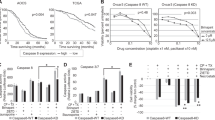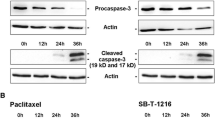Abstract
Two ovarian cancer cell lines named NOS4 and SKOV-3 have been shown to have different sensitivities to a cytotoxic anti-Fas antibody, CH-11. Although both cell lines express Fas molecules on the cell surfaces at the same intensities, apoptosis is induced by CH-11 in NOS4 cells but not in SKOV-3 cells. In this study, the different apoptosis-sensitivities of these cells were assessed. Both cell lines express almost the same levels of FADD, RIP, c-FLIP, FAP-1, Bax, Bcl-2 and Bcl-XL. Evidence of caspase-8, caspase-9 and caspase-3 activation and of cleavage of PARP and Bid was obtained in NOS4 cells but not in SKOV-3 cells. When triggered by FasL protein, DNA fragmentation and caspase-8 activation were observed in SKOV-3 cells, though they were not as clear as in NOS4 cells. All the anti-Fas antibody-mediated signals for apoptosis induction in NOS4 cells were completely blocked by a caspase-8-specific inhibitor, Z-IETD-FMK. These results indicate that the different sensitivities to the anti-Fas antibody are solely dependent on the activation of caspase-8, which could be influenced by yet unknown qualitative or quantitative abnormalities in molecules involved in DISC formation.
Similar content being viewed by others
References
Kerr JFR, Wyllie AH, Currie AR Apoptosis: A basic biological phenomenon with wide-ranging implications in tissue kinetics. Br J Cancer 1972; 26: 239–257.
Tanuma S Molecular mechanisms of apoptosis. In: Sluyser M., ed. Apoptosis in Normal Development and Cancer. London, UK: Taylor & Francis 1996: 39–59.
Yonehara S, Ishii A, Yonehara M, et al A cell-killing monoclonal antibody (anti-Fas) to a cell surface antigen codownregulated with the receptor of tumor necrosis factor. J Exp Med 1989; 169: 1747–1756.
Suda T, Takahashi T, Glstein P, et al Molecular cloning and expression of the Fas ligand, a novel member of the tumor necrosis factor family. Cell 1993; 75: 1169–1178.
Suda T, Okazaki T, Naito Y, et al Expression of the Fas ligand in cells of T cell lineage. J Immunol 1995; 154: 3806–3813.
Ormerod MG, Neil CE, Robertson D, et al Cisplatin induces apoptosis in a human ovarian carcinoma cell line without concomitant internucleosomal degradation of DNA. Exp Cell Res 1994; 211: 231–237.
Wakahara Y, Nawa A, Hayakawa A, et al Combination effect of anti-Fas antibody and chemotherapeutic drugs in ovarian cancer cells in vitro. Oncology 1997; 54: 48–54.
Hayakawa A, Yokoyama I, Tajiri H, et al Protein kinase Cdependent anti-apoptotic mechanism that is associated with high sensitivity to anti-Fas antibody in ovarian cancer cell lines. Cancer Letters 1999; 140: 113–119.
Schneider P, Holler N, Bodmer JL, et al Conversion of membrane-bound Fas(CD95) ligand to its soluble form is associated with downregulation of its proapoptotic activity and loss of liver toxicity. J Exp Med 1998; 187: 1205–1213.
Herrmann M, Lorenz HM, Voll R, et al A rapid simple method for the isolation of apoptotic DNA fragments. Nuclei Acids Res 1994; 22: 5506–5507.
Shiokawa D, Ohyama H, Yamada T, et al Identification of an endonuclease responsible for apoptosis in rat thymocytes. Eur J Biochem 1994; 226: 23–30.
Sato T, Irie S, Kitada S, et al FAP-1: A protein tyrosine phosphatase that associates with Fas. Science 1995; 268: 411–415.
Nakashima I, Zhang YH, Rahmn SM, et al Evidence of synergy between Thy-1 and CD3/TCR complex in signal delivery to murine thymocytes for cell death. J Immunol 1991; 147: 1153–1162.
Baker SJ, Reddy EP.Transducers of life and death:TNFreceptor superfamily and associated proteins. Oncogene 1996; 12: 1–9.
Baker SJ, Reddy EP Modulation of life and death by the TNF receptor superfamily. Oncogene 1998; 17: 3261–3270.
Krueger A, Schmitz I, Baumann S, et al c-FLIP splice variants inhibit different steps of caspase-8 activation at the CD95 death-inducing signaling complex (DISC). J Biol Chem, in press.
Nakai Y, Irie S, Sato T Identification of IκBα as a substrate of Fas-associated phosphatase-1. Eur J Biochem 2000; 267: 7170–7175.
Fuchs J, Karen A, Mckenna KA, Atul B P53-dependent DNA damage-induced apoptosis requires Fas/APO-1 independent activation of CPP32β. Cancer Res 1997; 57: 2550–2554.
Nishimura Y, Ishii A, Kobayashi Y, et al Expression and function of Fas antigen on immature and mature T cells. J Immunol 1995; 154. 4395–4403.
Hirata H, Takahashi A, Kobayashi S, et al Caspases are activated in a branched protease cascade and control distinct downstream processes in Fas-induced apoptosis. J Exp Med 1998; 187: 587–600.
Srinivasula SM, Ahmad M, Frenandes-Alnemri T, et al Autoactivation of procaspase-9 by apaf-1 mediated oligomerization. Mol Cell 1998;1: 949–957.
Jeong E, Bang S, Ho-Lee T, et al The solution structure of FADD death domain. J Bio Chem 1999; 274: 16337–16342.
Stanger BZ, Leder P, Lee TH, et al RIP: A novel protein containing a death domain that interacts with Fas/APO-1 (CD95) in yeast and causes cell death. Cell 1995; 81: 513–523.
Chinnaiyan AM, O'Rourke K, Tewari M, et al FADD, a novel death domain-containing protein, interacts with the death domain of Fas and initiates apoptosis. Cell. 1995; 81: 505–512.
Itoh N, Tsujimoto Y, Nagata S: Effect of bcl-2 on Fas antigenmediated cell death. J Immunol 1993; 151: 621–627.
Wang K, Yin XM, Chao DT: BID: A novel BH-3 domain-only death agonist. Genes & Develop 1996; 10: 2859–2869.
Li H, Zhu H, Xu C, et al Cleavage of BID by caspase-8 mediates the mitochondrial damage in the Fas pathway of apoptosis. Cell 1998; 94: 491–501
Horiuchi T, Himeji D, Tsukamoto H, et al Dominant expression of a novel splice variant of caspase-8 in human peripheral blood lymphocytes. Biochem Biophys Res Commun 2000; 272: 877–881.
Wolf B, Schuler M, Li W, et al Defective cytochrome c-dependent caspase activation in ovarian cancer cell lines due to diminished or absent apoptotic protease activating factor-1 activity. J Biol Chem 2001; 276: 34244–34251.
Author information
Authors and Affiliations
Rights and permissions
About this article
Cite this article
Hayakawa, A., Wu, J., Kawamoto, Y. et al. Activation of caspase-8 is critical for sensitivity to cytotoxic anti-Fas antibody-induced apoptosis in human ovarian cancer cells. Apoptosis 7, 107–113 (2002). https://doi.org/10.1023/A:1014302212321
Issue Date:
DOI: https://doi.org/10.1023/A:1014302212321




